Picture this: It was a chilly evening in Baguio City, and I had just finished a grueling day of mountain hiking. Exhausted and hungry, I followed the locals' advice to a tiny carinderia tucked away in the market district. The aroma hit me before I even sat down – this incredible smell of beef hitting a screaming-hot wok.
What landed on my table was Imbaliktad, a dish I'd never heard of but would never forget. Watching the cook work was like seeing a magic show – paper-thin beef strips dancing in the wok for mere minutes, transforming into this perfectly seared, medium-rare marvel swimming in a garlicky, vinegar-spiked sauce.
The owner, an Ilocano father, explained that this was his family's go-to recipe for busy nights and impromptu gatherings. Simple, quick, and absolutely delicious, this recipe has followed me home and become my own kitchen hero when I need something impressive in a flash.
Jump to:
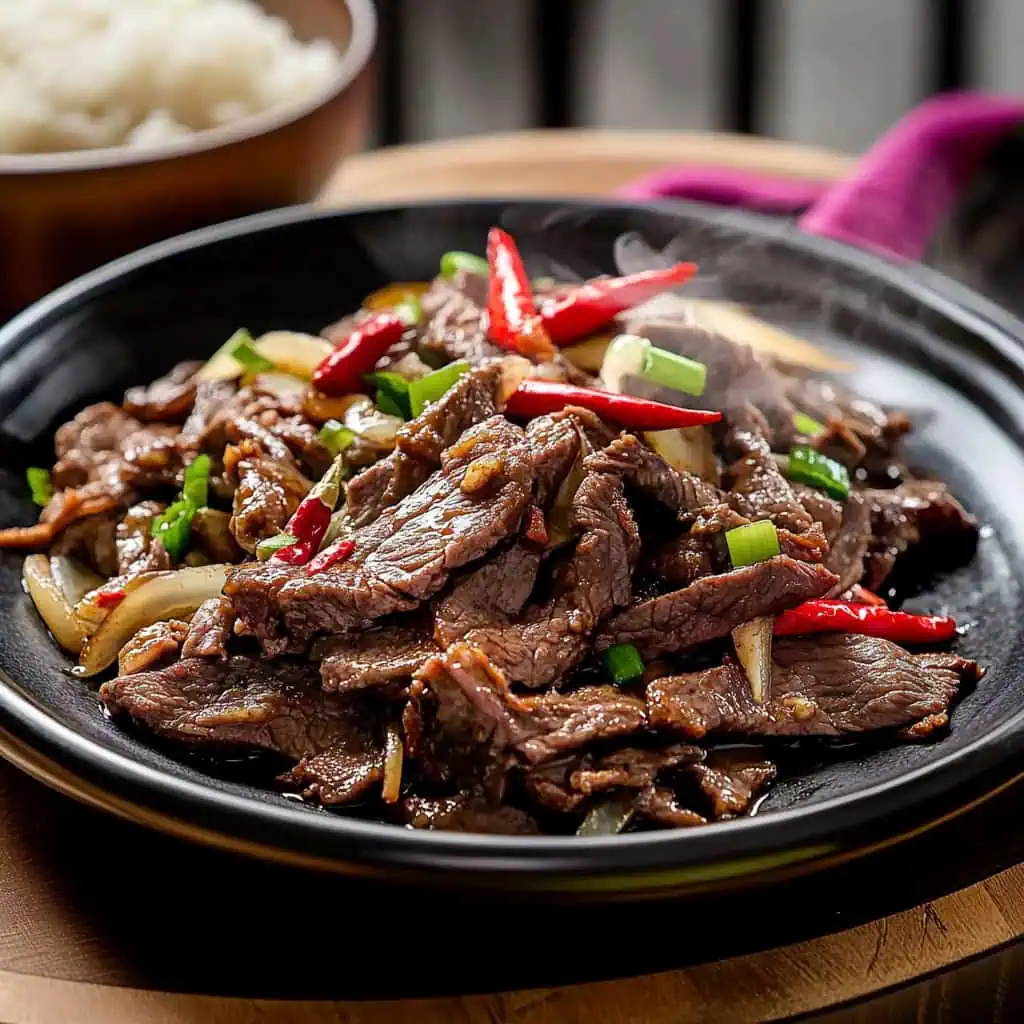
Why You'll Love This Recipe
- Quick & Easy: Ready in just 20 minutes with minimal prep
- Budget-Friendly: Uses simple, accessible ingredients
- Versatile: Perfect as pulutan (beer food) or a main dish with rice
- Authentic Taste: Traditional Ilocano recipe passed down through generations
- Restaurant Quality: Achieve that perfect medium-rare texture at home
Ingredients
The ingredients for Imbaliktad are carefully chosen to create a balance of bold flavors in minimal cooking time. Paper-thin beef provides tender texture that cooks quickly while absorbing flavors. Garlic, ginger, and red onion form an aromatic base that infuses the meat instantly under high heat.
Cane vinegar adds the signature tangy brightness that cuts through the richness of the beef, while also helping to tenderize it slightly. Red chilies bring gentle heat that complements rather than overwhelms. Spring onions add a fresh, mild onion flavor and vibrant color as a finishing touch.
This combination creates the perfect harmony of savory, tangy, and slightly spicy flavors that defines authentic Ilocano cuisine, all ingredients that cook rapidly to maintain the dish's hallmark quick preparation time.
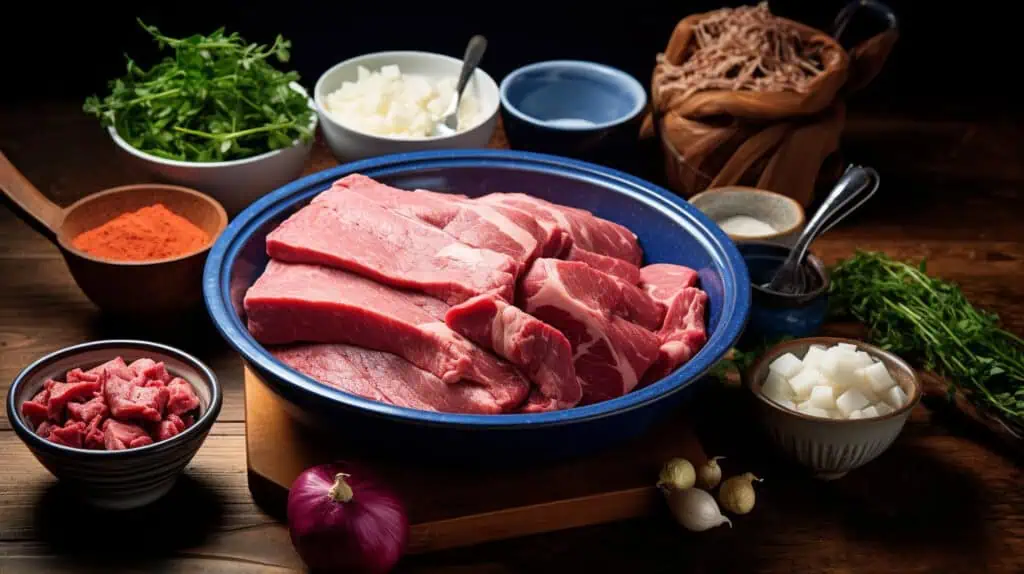
- 500g beef rump steak, sliced paper-thin against the grain
- 6 cloves garlic, minced
- 1 red onion, chopped
- 1 thumb-sized ginger, cut into thin matchsticks
- ⅓ cup cane vinegar
- 2 stalks spring onion, chopped
- 2 red chilies, sliced
- Salt, to taste
- Freshly ground black pepper, to taste
- 2 tablespoons cooking oil
Equipment
- Wok or large skillet: Essential for the high-heat searing that gives Imbaliktad its characteristic flavor and texture. The curved shape allows for quick movement of ingredients.
- Sharp knife: Necessary for slicing beef paper-thin. A well-sharpened knife makes all the difference in achieving the perfect meat thickness.
- Cutting board: Preferably with juice grooves to catch any liquid from the meat during preparation.
- Metal spatula or wok turner: Needed for the constant movement of ingredients during the quick stir-fry process. Metal is best as it can withstand the high heat.
- Measuring cups and spoons: For precise portioning of ingredients, especially the vinegar which provides the signature tang.
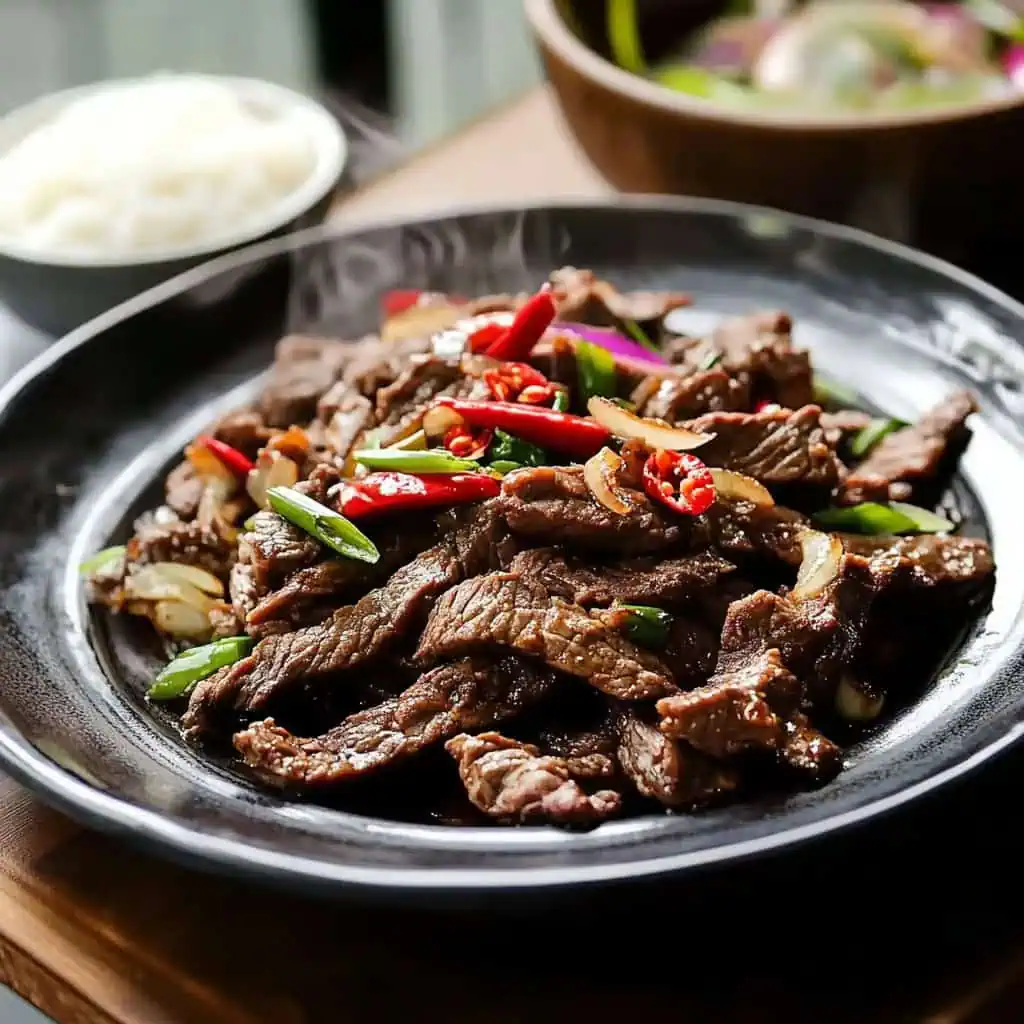
How To Make
- Start with a screaming hot wok over your highest heat setting. You'll know it's ready when you see a wisp of smoke. Add your oil and let it heat until it's shimmering – this is crucial for that perfect sear we're after.
- Keep all your ingredients close by because once we start, things move fast. When your wok is smoking hot, toss in your paper-thin beef strips, minced garlic, chopped red onion, and matchstick ginger all at once. Using your spatula or wok turner, keep everything moving constantly – think of it like a dance. The beef will start changing color almost immediately.
- After about two minutes of non-stop stir-frying, pour in your cane vinegar while keeping that high heat going. Let it hit a rapid boil – you'll catch that sharp, tangy aroma right away. This quick boil, about 30 seconds, mellows the vinegar and coats the meat perfectly.
- Throw in your sliced red chilies and chopped spring onions. Season with salt and freshly ground black pepper until it tastes just right. The whole cooking process should take no more than 5 minutes from start to finish.
- Get it straight onto your serving plate. You'll know you've nailed it if the beef is nicely browned outside but still juicy and medium-rare inside. Those reddish juices on your plate? That's flavor gold right there – perfect for drizzling over rice. Serve it up while it's still sizzling hot.

Tips from Lola's Kitchen
- Prep is everything: Have all ingredients cut, measured, and ready to go before heating your wok. Once cooking starts, there's no time to chop or slice.
- The freezer trick: Freeze beef for 30 minutes before slicing for easier, paper-thin cuts. A slightly firm steak is much easier to slice thinly.
- Wok temperature matters: Your wok must be smoking hot before adding ingredients. If it's not hot enough, you'll steam the meat instead of searing it.
- Keep it moving: Never stop stirring during the entire cooking process. This ensures even cooking and prevents burning.
- Don't overcrowd: Cook in batches if making a larger portion. Too much meat in the pan lowers the temperature and prevents proper searing.
- The cut matters: Ask your butcher for beef with good marbling – those little streaks of fat add incredible flavor when flash-seared.
- Timing is crucial: Imbaliktad should be served immediately after cooking. The dish loses its magic if it sits too long.
Substitutions
- Beef: If rump steak isn't available, sirloin, ribeye, or tenderloin work beautifully. For a budget option, flank steak can work if sliced very thinly.
- Cane vinegar: White vinegar or rice vinegar can be used (reduce amount by about 1 tablespoon as they're stronger).
- Red chilies: Green chilies for a different heat profile, or bell peppers for a milder version.
- Spring onions: Leeks or chives work as alternatives, though they'll alter the flavor slightly.
- Cooking oil: Any high smoke point oil works – canola, vegetable, or peanut oil are all good choices.
- Ginger: If you're not a fan, you can reduce the amount or substitute with a teaspoon of five-spice powder for a different dimension.
Troubleshooting
- Tough meat: This usually means the beef slices are too thick or weren't cut against the grain. Solution: Slice thinner and make sure to cut perpendicular to the muscle fibers.
- Too sour: Add a pinch of sugar or a teaspoon of honey to balance the acidity from the vinegar.
- Meat not browning properly: Your wok wasn't hot enough before adding ingredients or was overcrowded. Solution: Work in smaller batches with a hotter wok.
- Burning garlic: If your garlic burns quickly, add it after the beef has started to brown instead of at the beginning.
- Too dry: Add a splash of beef broth or water if the mixture seems too dry after adding vinegar.
- Bland result: Make sure to season properly with salt and pepper after the vinegar has reduced slightly.
Storage & Reheating
- Short-term storage: Refrigerate in an airtight container for up to 2 days. The flavors will meld further but the texture will change.
- Reheating method: For best results, use a hot wok or skillet and quickly stir-fry just until heated through (about 1 minute). Overcooking during reheating will toughen the meat.
- Not freezer-friendly: Imbaliktad is not recommended for freezing as the texture of the meat will deteriorate significantly.
- Make ahead components: You can prep all the ingredients up to 4 hours ahead and store separately in the refrigerator, but the actual cooking should be done just before serving.
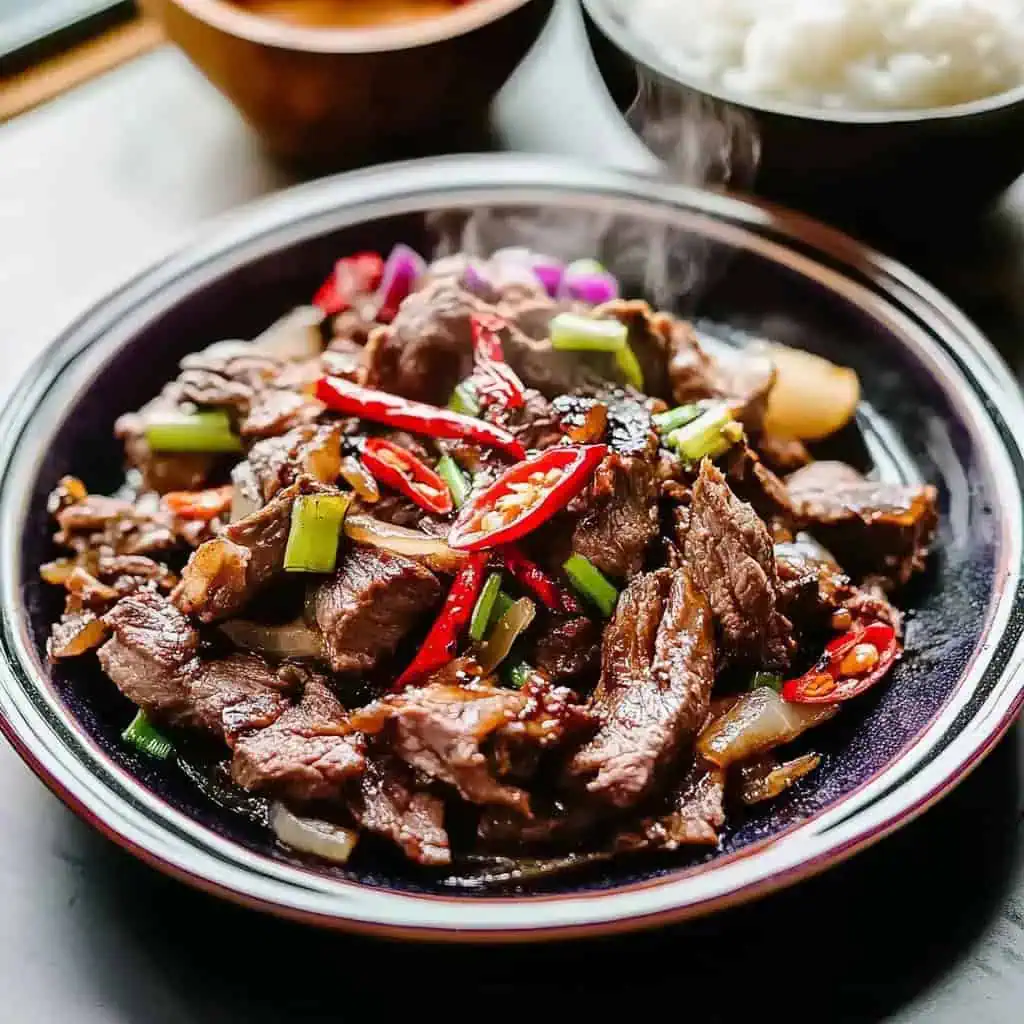
FAQ
Why is it called Imbaliktad?
The name comes from the Ilocano word "baliktad" meaning "to turn over," referring to the quick stir-frying technique where the ingredients are constantly turned and tossed.
Can I make this well-done instead of medium-rare?
Yes, though traditionally it's served medium-rare. For well-done beef, extend cooking time by 1-2 minutes, but be aware the meat may become tougher.
Is this dish spicy?
It's moderately spicy with 2 red chilies, but you can easily adjust to your preference – remove the seeds for less heat or add more chilies for extra spice.
What's the best cut of beef to use?
Rump steak is traditional, but any cut with some marbling works well. Sirloin and ribeye are excellent alternatives that remain tender when quickly cooked.
Can I add vegetables to make it a complete meal?
While not traditional, you can add quick-cooking vegetables like bell peppers, mushrooms, or snow peas in the last minute of cooking.
What's the best vinegar to use?
Cane vinegar (sukang iloco) is authentic, but rice vinegar or white wine vinegar can substitute. Each will give a slightly different flavor profile.
How do I know when the beef is cooked perfectly?
The beef should have a caramelized exterior but still be slightly pink inside. It will continue to cook slightly from residual heat after plating.
Can I prepare the ingredients ahead of time?
Yes, you can slice and prepare all ingredients up to 4 hours ahead. Store them separately in the refrigerator until ready to cook.
Related
Looking for other recipes like this? Try these:
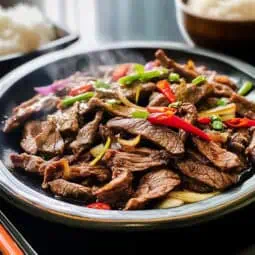
Authentic Ilocano Imbaliktad (Quick-Seared Beef Stir-Fry)
Equipment
- Wok or large skillet: For high-heat searing (Kawali in Filipino)
- Sharp knife: For slicing beef thinly (Kutsilyo)
- Cutting board: Preferably with juice groove for meat (Sangkalan))
- Metal spatula or wok turner: For quick stir-frying (Siyansi)
- Measuring cups and spoons: For precise portioning (Panukat)
Ingredients
- 500 g beef rump steak Karne ng baka, sliced paper-thin against the grain
- 6 cloves garlic Bawang, minced
- 1 red onion Sibuyas, chopped
- 1 thumb-sized ginger Luya, cut into thin matchsticks
- ⅓ cup cane vinegar Suka
- 2 stalks spring onion Sibuyas dahon, chopped
- 2 red chilies Siling labuyo, sliced
- Salt Asin, to taste
- Freshly ground black pepper Paminta, to taste
- 2 tablespoons cooking oil Mantika
Instructions
- Start with a screaming hot wok over your highest heat setting. You'll know it's ready when you see a wisp of smoke. Add your oil and let it heat until it's shimmering – this is crucial for that perfect sear we're after.
- Keep all your ingredients close by because once we start, things move fast. When your wok is smoking hot, toss in your paper-thin beef strips, minced garlic, chopped red onion, and matchstick ginger all at once. Using your spatula or wok turner, keep everything moving constantly – think of it like a dance. The beef will start changing color almost immediately.
- After about two minutes of non-stop stir-frying, pour in your cane vinegar while keeping that high heat going. Let it hit a rapid boil – you'll catch that sharp, tangy aroma right away. This quick boil, about 30 seconds, mellows the vinegar and coats the meat perfectly.
- Throw in your sliced red chilies and chopped spring onions. Season with salt and freshly ground black pepper until it tastes just right. The whole cooking process should take no more than 5 minutes from start to finish.
- Get it straight onto your serving plate. You'll know you've nailed it if the beef is nicely browned outside but still juicy and medium-rare inside. Those reddish juices on your plate? That's flavor gold right there – perfect for drizzling over rice. Serve it up while it's still sizzling hot.
- Quick tip: Success comes down to prep work. Have everything ready to go before you start cooking because once that wok heats up, there's no time to chop or slice. And make sure your beef is sliced as thin as you can get it – partially freezing it first helps here.
Tips from Lola's Kitchen
- Freeze beef for 30 minutes before slicing for easier, thinner cuts
- Use high smoke point oil like canola or vegetable oil
- Don't overcrowd the pan - cook in batches if needed
- Keep ingredients moving constantly to prevent burning
- Serve immediately while hot for best texture
Nutrition
The Story Behind Ilocano Imbaliktad
In the misty mountains of Northern Luzon, where the cool highland breeze meets centuries-old culinary traditions, Imbaliktad emerged as a testament to Ilocano ingenuity. This distinctive beef dish, whose name derives from the Ilocano word "baliktad" meaning "to turn over," tells a story of resourcefulness and culinary precision that has been passed down through generations of Filipino families.
The origins of Imbaliktad can be traced back to the bustling markets of Ilocos, where merchants and farmers would gather after long days of trade. Local cooks discovered that quickly searing thin strips of beef over intense heat not only preserved the meat's tenderness but also created a dish that could be prepared in minutes – a crucial consideration for busy market vendors and workers seeking quick, satisfying meals.
What began as a practical solution for time-pressed traders soon evolved into a beloved staple of Ilocano cuisine, particularly in the mountain city of Baguio. The dish's popularity soared among university students and young professionals during the 1960s and 1970s, who appreciated its simplicity, affordability, and versatility. Whether served as pulutan alongside cold beer or as a main dish with steaming rice, Imbaliktad became synonymous with casual dining and impromptu gatherings.
The technique behind Imbaliktad showcases the sophisticated understanding of heat control in Filipino cooking. The intense heat of the wok, combined with paper-thin slices of beef and a precise cooking time, creates a delicate balance of textures – caramelized exterior giving way to a tender, medium-rare center. This method, while appearing simple, requires skill and timing that home cooks have traditionally learned through careful observation and practice.
Today, Imbaliktad represents more than just a quick meal; it embodies the Ilocano philosophy of making the most of simple ingredients. The dish demonstrates how basic elements – beef, garlic, ginger, and vinegar – can be transformed through technique and timing into something extraordinary. As Filipino cuisine gains global recognition, Imbaliktad stands as a prime example of the region's ability to create memorable flavors through straightforward, thoughtful cooking methods.
In modern Filipino households, particularly in the Cordillera region, Imbaliktad continues to evolve while maintaining its essential character. Some families add their own twists – an extra dash of chilies, a splash of calamansi, or additional aromatics – but the core technique remains unchanged, preserving the dish's heritage while allowing for personal expression. This adaptability, combined with its quick preparation time and satisfying results, ensures Imbaliktad's place in both traditional and contemporary Filipino kitchens.










Comments
No Comments